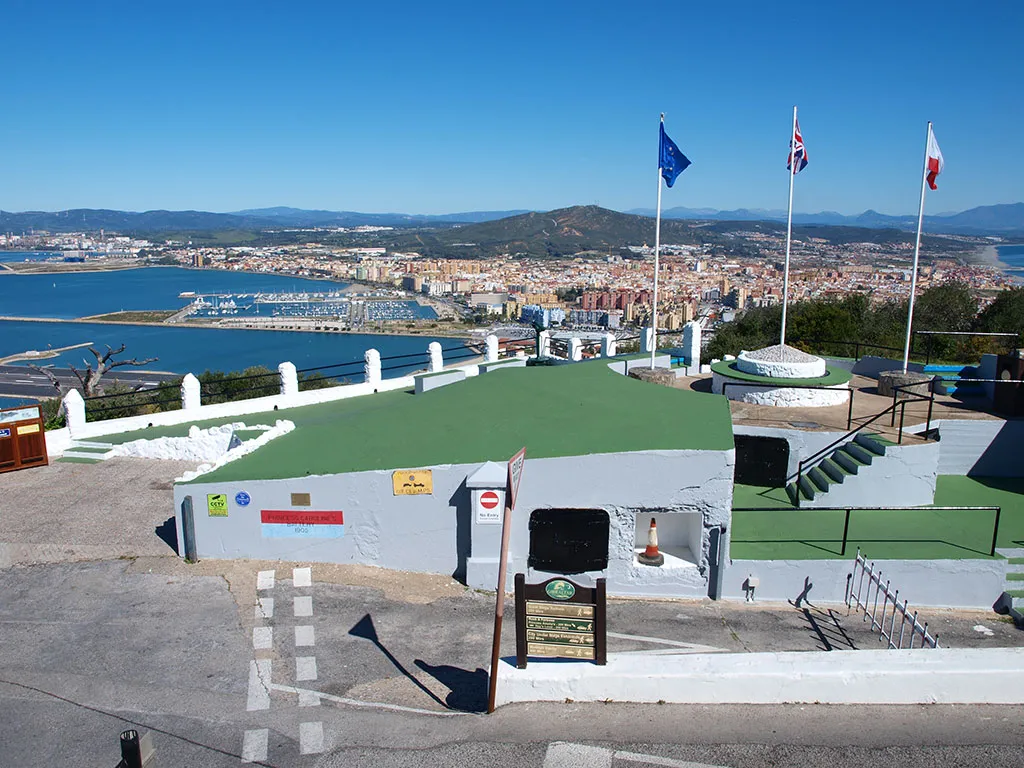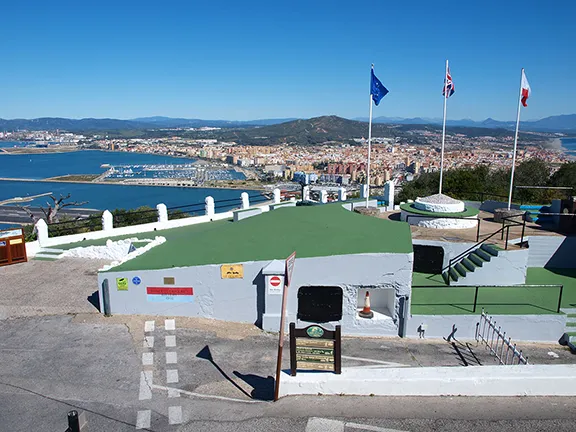Following the fall of France in June 1940, Gibraltar was the only allied territory left in Europe. By July, Hitler was already considering ways to capture Gibraltar, either by sending German forces through Spain or supporting Franco in a Spanish operation. This plan was known as Operation Felix. What is not widely known is that the allies also had plans to thwart any such attack on Gibraltar. The allied plans were known as Operation Blackthorn a plan to occupy part of Spain, Goldeneye, the Naval plans, Relator, plans for the Special Operations Executive, Sprinkler, to aid Spanish army resistance to a German invasion, and Sconce, a plan to start guerrilla operations with former Republicans.
By Nick Nutter | Updated 4 Jun 2023 | Gibraltar | History |
Login to add to YOUR Favourites or Read Later


Princess Caroline Battery, Gibraltar. WWII gun emplacement
The British ambassador in Madrid, Sir Samuel Hoare, through his relationship with the Spanish Foreign Minister, Juan Beigbeder, (who was sacked on the 17th October 1940), calculated that Germany would demand a right of passage through Spain and there was a fifty – fifty chance that Franco would accede. Beigbeder thought the best chance to thwart such a plan was to use the Spanish army to resist the Germans, in which case, even the Basque and Catalans would join a national movement to fight the invaders. Britain, Beigbeder warned, should be ready to provide munitions and support to Gibraltar and to the regional commander in the south, General Agustin Muñoz Grandes.
The British ambassador in Madrid, Sir Samuel Hoare, through his relationship with the Spanish Foreign Minister, Juan Beigbeder, (who was sacked on the 17th October 1940), calculated that Germany would demand a right of passage through Spain and there was a fifty – fifty chance that Franco would accede. Beigbeder thought the best chance to thwart such a plan was to use the Spanish army to resist the Germans, in which case, even the Basque and Catalans would join a national movement to fight the invaders. Britain, Beigbeder warned, should be ready to provide munitions and support to Gibraltar and to the regional commander in the south, General Agustin Muñoz Grandes.
A further potential problem that had to be accounted for was the presence of howitzers and artillery in reinforced bunkers on the high ground behind La Linea. Built with German assistance, these fortifications directly threatened Gibraltar. Franco was determined that if Gibraltar was to be taken at all, it would be by Spain. They were part of Franco’s Plan of Fortifications of the Southern Border, devised by the artillery brigadier general Pedro Jevenois Labernade in May 1939.
The fortifications extend along the coastline of Cádiz, from Huelva to Málaga and consist of bunkers, anti-aircraft guns, command posts, tunnels and even a hidden road to Algeciras. Over 640 military structures were built by 30,000 prisoners working in disgraceful conditions. Gabriel Riera was one such prisoner forced to eat crushed snails to avoid starvation while digging a huge tunnel under the Sierra Carbonera range of hills opposite La Linea.
On the 17th October 1940, Hoare sent a telegram to London and the War Cabinet asked the Chiefs of Staff to prepare a plan for operations in Spain. Admiral Sir Charles Saumarez Daniel, Director of Plans at the Admiralty, Major-General Sir Ian Stanley Ord Playfair, Director of Plans for the army and Air Chief Marshal Sir Charles Edward Hastings Medhurst, RAF Secretary of the Supreme War Council, were charged with the task of planning operations that would ‘enable us [Britain] to maintain our present degree of control of the Straits of Gibraltar’. The plan was delivered in a remarkably short space of time, by the 6th November 1940, which makes one think this high powered team already had contingency plans prepared.
Operation Blackthorn was a plan to defend a line from Cádiz to Málaga with contingency plans to fall back to secure the Tarifa Peninsula and Gibraltar. Four divisions, two army tank brigades, two anti-aircraft brigades, six fighter squadrons and two medium bomber squadrons were earmarked for the task. Gibraltar would be reinforced with an extra 5500 RAF and army personnel with a thousand vehicles and 4500 tons of stores.
Operation Sprinkler was a plan to assist the Spanish army in the event they resisted a German invasion of Spain.
Conversely, if the Franco regime helped Germany move through Spain, Operation Sconce would come into effect. SOE trained 140 Spaniards, former Republicans, to allow them to conduct successful guerrilla and sabotage operations against the German forces.
Operation Relator was the name given to the training of a party of area commanders to be used in Spain. They were also known as "Ali Baba and the 20 thieves". Their purpose was to delay the enemy in any advance into Spain. Nineteen officers and seven signallers recruited for the Special Operations Executive arrived on Gibraltar in April 1941 on the ‘Q’ ship Fidelity, ready to begin the job. SOE soon realised that the original plan was unworkable, and it was incorporated into Operation Goldeneye.
The aim of Operation Goldeneye was to ensure that Britain would still be able to communicate with Gibraltar in the event Spain joined, or was invaded by, the Axis powers, and to carry out sabotage operations. In August 1940, responsibility for drawing up the plan was given to Lieutenant Commander Ian Fleming of the Naval Intelligence Department. Of particular concern to Fleming was the possible installation of radar equipment and infrared cameras in the Straits of Gibraltar, which would have been a threat to the Navy's Mediterranean strategy and to the Allied's shipping interests in the Atlantic.
Operation Goldeneye later incorporated an alternative plan to Relator, using the Relator officers who would become “a small highly trained commando for use in ... attacks on shipping, raiding parties, and other local operations based on Gibraltar”.
On Monday 24th February 1941, the Governor of Gibraltar, General Sir Clive Gerard Liddell, held a dinner party for a distinguished guest, William Joseph "Wild Bill" Donovan, best known for serving as the head of the Office of Strategic Services (OSS), the precursor to the Bureau of Intelligence and Research and the Central Intelligence Agency. Donovan was on an extended tour of allied bases in North Africa and Europe travelling as an informal emissary to Britain, where he was urged by Secretary of the Navy Knox and President Roosevelt to gauge Britain's ability to withstand Germany's aggression. Lieutenant Colonel Vivian Dykes of the Royal Engineers was appointed by Winston Churchill to accompany Donovan on his travels. Unfortunately for Donovan he missed the dinner; he was having a cyst removed from his eye at the time, because the party included some interesting guests.
The party included Brigadier Reggie Parminster, Gibraltar’s Chief Administrative Officer, Major Anthony Quayle, who later became a famous actor, and Lieutenant Peter Forbes, the governors Aide de Camp, Captain Alan Hillgarth, the naval attaché from Madrid and his wife, Mary and Acting Commander Ian Lancaster Fleming RNVR, the personal assistant to the Director of Naval Intelligence, Admiral John Godfrey (who inspired the character ‘M’ in the Bond books and films).
Fleming’s portfolio included Iberia and he had driven from Madrid the previous week with the Hillgarths. Mary Hillgarth recalls that Fleming flew a small white ensign from his car’s radio aerial during the journey. Fleming and Hillgarth, also in Naval Intelligence, were responsible for various aspects of Operation Goldeneye. During his visit to Gibraltar, Fleming is credited with the concept of Operation Tracer, the ‘stay behind plan’ that was incorporated into Operation Goldeneye.
Whilst in Gibraltar, Fleming set up a Goldeneye liaison office with a secure cipher link to London, under the control of H.L. Greensleeves, a fellow Naval Intelligence Department agent. Fleming also set up a similar office in Tangier as a fallback in the event of the German occupation of Gibraltar.
After the war, Fleming named his Jamaican estate "Goldeneye", and it was there he wrote the James Bond novels. The name was also used for the title of the seventeenth James Bond film, Goldeneye starring Pierce Brosnan as James Bond.
Hillgarth provided much of the background to the plan for the guerrilla campaign and sabotage that would follow German presence on the Iberian Peninsula; Operation Sconce and Relator as incorporated into Goldeneye.
Under Fleming and Hillgarth’s dynamic leadership, personnel, stores and operation orders were prepared for the carrying out of demolitions at Cádiz, Málaga, Huelva, Seville, Lisbon, Cartagena and Alicante, and either the Balearics, or Valencia, Oporto or Almeria as circumstances dictated.
The plans also included an operation to sabotage the Spanish guns threatening Gibraltar, a mission that could be accomplished within 12 to 14 hours of a German invasion of Spain. Reminiscent of ‘The Sortie’ during the Great Siege of Gibraltar.
The following day, the 25th February 1941, the Hillgarths, Fleming, Donovan and Dykes motored back to Madrid in two cars. Dykes and Fleming traveled in one car, swapping war stories. Dykes remarked in his diary that Fleming had not lost the journalistic habit of drinking too much. Both had also noticed that General Noel Mason-MacFarlane, then the second-in-command of Gibraltar City and Garrison, a position that allowed him to head the Joint Intelligence Centre and so in charge of all operations on Gibraltar, was busy intriguing against the sitting governor, Sir Clive Liddell. MacFarlane replaced Liddell, whom Macfarlane regarded as ‘a useless poop’, on the 31st May 1942.
Germany never invaded Spain and Spain never assaulted the Rock. All the planned operations were put on a back burner. Many of the plots and characters from this time were to form the themes for Ian Fleming’s future books.
Large parts of Franco’s ‘Fortifications of the Southern Border’ are still to be seen and some, in the vicinity of San Roque, can be visited. On the Rock itself the tunnels used to house the military personnel, the war rooms, hospital, store rooms and communications shacks are still there. Some are still used by the military and some are open to the public.